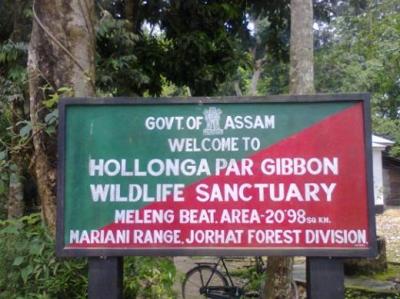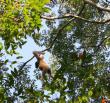|
Gibbon Wildlife sanctuary is houses Seven out of only 15 species of Apes in India. It was given the status of a wildlife sanctuary in the year 1997 by the Assam Government vide notification no. FRS 37/97/31 . Set aside initially in 1881, its forests used to extend to the foothills of the Patkai mountain range. Since then, the forest has been fragmented and surrounded by tea gardens and small villages. In the early 1900s, artificial regeneration was used to a develop well-stocked forest, resulting in the site's rich biodiversity. The Hoollongapar Gibbon Sanctuary contains India's only gibbons – the hoolock gibbons, and Northeastern India's only nocturnal primate – the Bengal slow loris. The upper canopy of the forest is dominated by the Hollong tree (Dipterocarpus macrocarpus), while the Nahar (Mesua ferrea) dominates the middle canopy. The lower canopy consists of evergreen shrubs and herbs. The habitat is threatened by illegal logging, encroachment of human settlements, and habitat fragmentation.
Hoollongapar Sanctuary contains India's only ape family - the Hoolock Gibbon, numbering about 106. Other primates in the sanctuary include the Stump-tailed Macaque (Henduri Bandor in Assamese) which are some 233 in number, the Pig-tailed Macaque which are left with a population of 75 only, the Capped Langur with just 162, 174 Rhesus Macaques, and the Slow Loris (Lajuki Bandor) whose estimation is yet to be made.
The sanctuary officially extends to the Dissoi Valley Reserve Forest, Dissoi Reserve Forest, and Tiru Hill Reserve Forest, which are used as dispersal areas for Indian elephants (Elephas maximus indicus) and other animals. Three extensive tea gardens that belong to the estates of Dissoi, Kothalguri, and Hoolonguri span the distance between the Hoollongapar Gibbon Sanctuary and the nearest forests in Nagaland, the Dissoi Valley Reserve Forest. The tea gardens include Katonibari, Murmurai, Chenijan, Koliapani, Meleng, Kakojan, Dihavelleoguri, Dihingapar, Kothalguri, Dissoi and Hoolonguri. Neighboring villages include Madhupur, Lakhipur, Rampur, Fesual A (the western part), Fesual B (the eastern part), Katonibari, Pukhurai, Velleoguri, Afolamukh, and Kaliagaon.
The main concern in the reserve is that the habitat is being threatened by illegal trees felling encroachment by human settlements and habitat fragmentation. Collection of large quantities of leaves and grasses from the forest bed to feed cattle poses interferences.The tea gardens are used by elephants as a corridor to Nagaland, making them vulnerable to frequent poaching. Railway lines further divide the park, stranding a single group of gibbons in a small fragment of the sanctuary.
This sanctuary is famous for its non- human primate diversity.Seven out of nine species of non human primates found in North Eastern India are found in this sanctuary.It includes Hoolock Gibbon,Capped Langur,Slow Loris,Rhesus Macaque, Assamese Macaque,Pigtailed Macaque & Stump tailed Macaque.Other mammals found in this sanctuary are _ Leopard, Leopard Cat, Jungle Cat, Chinese Pangolin, Wild Boar, Squirrel, Asian Elephant, Indian Fox,Civet Cat, Bats etc.Many different varieties of Lizard,Python, Cobra , Turtles are also found in this sanctuary.
Due to the high density of primate population within this relatively small geographical area, the bird’s nest & their eggs are devoured by the primates of the sanctuary;hence the number of birds ae relatively less.Among the birds found in this sanctuary are__ Hornbill, Green Pigeaon, Owl,Woodpecker, Dove, Bulbul, Black headed Oriole, Drongo, Barbet, different species of Egrets etc.
Different varieties of bamboo, cane, orchids, ferns are found in abundance along with the trees like Holong, Sashi, Holokh, Sam, kothal (Jack Fruit), Ajar, Titachopa,Seleng etc in the thik forests of Gibbon Wildlife Sanctuary.
Gibbon Wildlife sanctuary is important also for these reasons :
1. It is Recognized as Important Bird Area situated in Assam(IBA) by Bird Life International because it is habitation of almost 800 different species of birds of which several are extinct .
2. Hoolock gibbon is only ape (which doesnot have a tail , lives on trees ) .
3. Habitat of lots of rare and priceless species of trees and other animals .
The Holongapar Gibbon Wildlife Sanctuary is a treat for Nature lovers in Asssam.
How to reach Gibbon Wildlife sanctuary :
By Air : Nearest airport is Jorhat . It is 22 Km away from Jorhat Town .
By Rail : Mariani is the nearest Junction . It is only a five minutes drive from Mariani rail station .
By Road : Mariani is well connected by motorable road
Best season for visit Gibbon Wildlife sanctuary : Throughout the year but best during June to July & February to March.
Where to stay in Gibbon Wildlife sanctuary : Gibbon Forest Rest House(a small rest house located within the Sanctuary). For reservation contact Divisional Forest Officer, Jorhat Division, Tel.- +91-376-2320008/2320456. Prasanti Tourist Lodge under Assam Tourism Department located in Jorhat town, 22 kms. away from the Sanctuary. For reservation contact the Deputy Director, Tourism Department, Jorhat. There are also many good Hotels at Jorhat town.
Whom to contact for visit Gibbon Wildlife sanctuary :
1) The Divisional Forest Officer, Jorhat Division,
Jorhat, Pin. 785001,
Tel.- +91-376–2320008/2320456
2) Forest Range Officer, Mariani Range,
P.O. Mariani, Dist.–Jorhat,
Tel.- +91-3771-244125.
2) Mr. Golap Gogoi
Private wildlife Guide & tour operator
Ph. +91 9864518364, +91 9401644899
Email : golap7@gmail.com/golab_gogoi@yahoo.com
To know more about Jorhat, please click here
|







